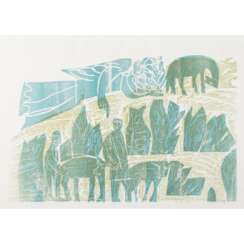552 Items by auctions and galleries:
cute animals
Lot 1806 GRIESHABER, H. A. P. (Helmut Andreas Paul, 1909-1981), "Angel over landscape with shepherds and animals",
HAP Grieshaber (1909 - 1981)  Kunst & Antiquitäten
Kunst & Antiquitäten 

HAP Grieshaber
15.02.1909 - 12.05.1981
Germany
Helmut Andreas Paul Grieshaber or HAP Grieshaber was a German artist. His preferred medium was large format woodcuts.

EPPLI Auktionshaus
Kunst & Antiquitäten
Date: 24.06.2023 10:00 UTC +00:00
Number of lots in the catalog: 319
Lot 2225 GREUBEL FORSEY. A MAGNIFICENT AND SPECIALLY EXECUTED PLATINUM ASYMMETRICAL WRISTWATCH WITH DIFFERENTIAL QUADRUPLE TOURBILLON AND POWER RESERVE INDICATION
The Champion Collection Part VI: The Finest Watchmaking 

CHRISTIE'S
The Champion Collection Part VI: The Finest Watchmaking
Date: 27.11.2022 19:00 UTC +08:00
Number of lots in the catalog: 82
Lot 2244 JAEGER-LECOULTRE. A PLATINUM AND CALIBRE-CUT DIAMOND-SET PERPETUAL CALENDAR WRISTWATCH WITH DIGITAL YEAR DISPLAY, DAY/NIGHT, ADJUSTMENT WARNING INDICATOR, 8-DAYS POWER RESERVE AND MOON PHASES
Jaeger-LeCoultre
The Champion Collection Part VI: The Finest Watchmaking 

CHRISTIE'S
The Champion Collection Part VI: The Finest Watchmaking
Date: 27.11.2022 19:00 UTC +08:00
Number of lots in the catalog: 82































































